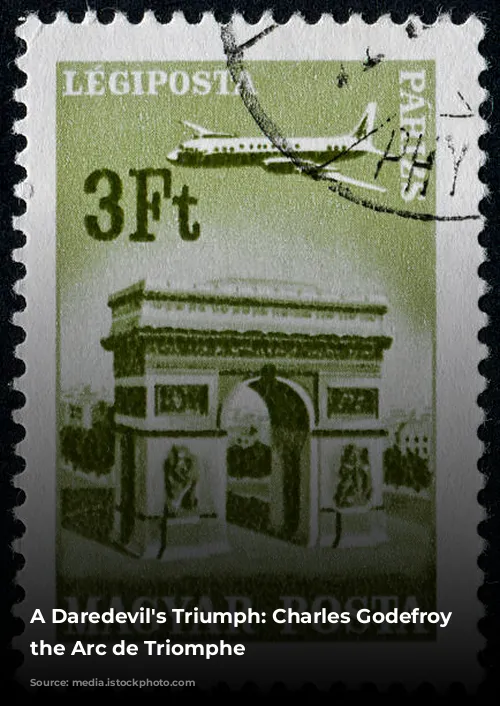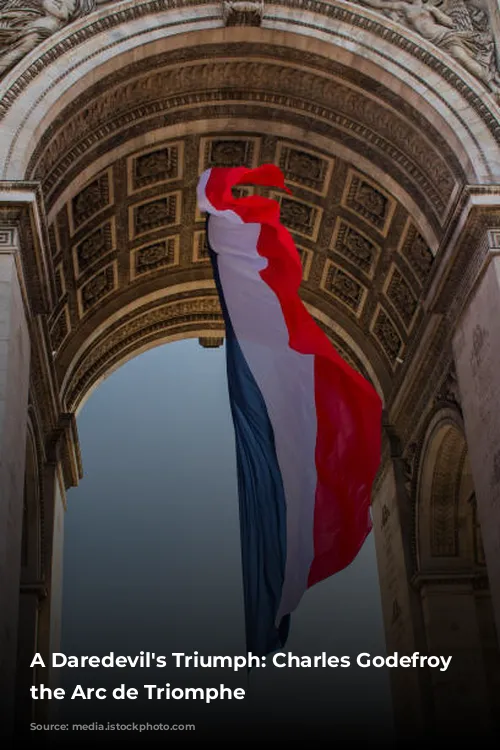Charles Godefroy, a French aviator, etched his name in history with a daring feat that captivated the world. He is best known for his audacious flight through the Arc de Triomphe in Paris in 1919. This incredible act of bravery cemented his legacy as a pioneering aviator.
From Soldier to Aviator
Godefroy’s journey to becoming a flying legend began during World War I. In 1914, at the age of 26, he was called up for military service. After enduring the hardships of war and recovering from injuries, he joined the French Air Force in 1917. His natural aptitude for flight quickly became evident, and he excelled in his training, becoming a skilled pilot.
A Flight of Defiance
The end of the war marked a moment of triumph for France. A grand victory parade was planned on the Champs Élysées in 1919. However, a decree from the military command mandated that airmen participate “on foot”, like infantry soldiers. This directive was met with outrage by the aviators, who felt disrespected and undervalued. They considered themselves “heroes of the air” and sought to challenge this perceived slight.
A group of aviators gathered at Le Fouquet’s, a renowned bar on the Champs Élysées, to discuss their grievances. They decided to make a bold statement by flying a plane through the Arc de Triomphe during the parade. The initial choice fell on Jean Navarre, a highly decorated flying ace. Sadly, Navarre tragically died in a practice flight just before the parade.
Godefroy Takes the Challenge
Godefroy, with 500 hours of flight experience, stepped forward to honor Navarre’s memory. He volunteered to take on the perilous task. Alongside his close friend, journalist Jacques Mortane, Godefroy meticulously inspected the Arc de Triomphe, studying the air currents and mapping out a flight path. He practiced the maneuver at a bridge over the Rhône River in Miramas.
A Moment of Glory
On August 7, 1919, three weeks after the parade, Godefroy embarked on his daring flight. He took off from the Villacoublay airfield in a Nieuport 27 biplane. With nerves of steel, he approached the Arc de Triomphe from the west, circling it twice before gathering speed and diving his aircraft through the iconic monument. The gap between the wings of his plane and the Arc’s 14.5-meter width was minimal, leaving little room for error.
His daring maneuver sent shockwaves through the city. Passengers on a tram below scrambled for safety, while pedestrians fled in panic. Godefroy, unfazed, continued his flight over the Place de la Concorde before returning to the airfield. The entire flight lasted just half an hour.
Hidden Heroism
Despite the obviousness of his act, Godefroy remained officially silent. His identity was kept secret, but it could not be concealed forever. Mortane, who had captured the entire event on film and photographs, faced official censorship, with the Commissioner of Police banning the screening of his footage.
The authorities, wary of the precedent Godefroy’s flight set and fearing copycats, reprimanded him. However, Godefroy’s legacy lived on, inspiring future generations of aviators.
A Lasting Legacy
Following this daring act, Godefroy decided to retire from flying, fulfilling a promise he made to his family. He dedicated his time to his wine trade in Aubervilliers. He passed away in 1958 at the age of 70, leaving behind a story of incredible courage and skill. His hometown of Soisy-sous-Montmorency honored his memory by naming a street and erecting a memorial stone in his honor.
Godefroy’s daring flight through the Arc de Triomphe remains an iconic moment in aviation history. It stands as a testament to the human spirit’s capacity for bravery and its enduring desire to push the boundaries of what is possible. Although two other pilots have attempted the feat, Godefroy’s flight remains a symbol of daring and skill.














